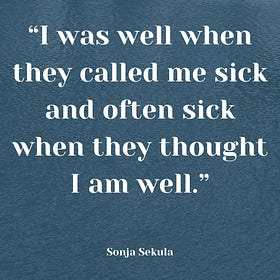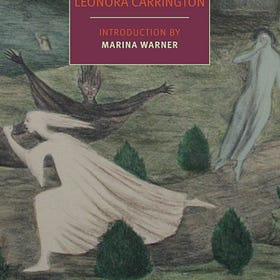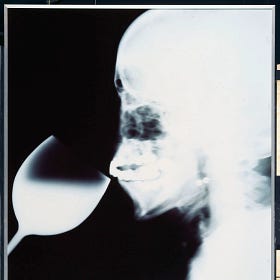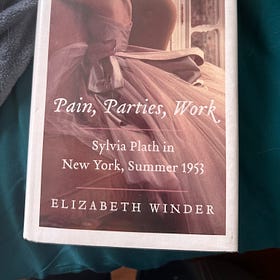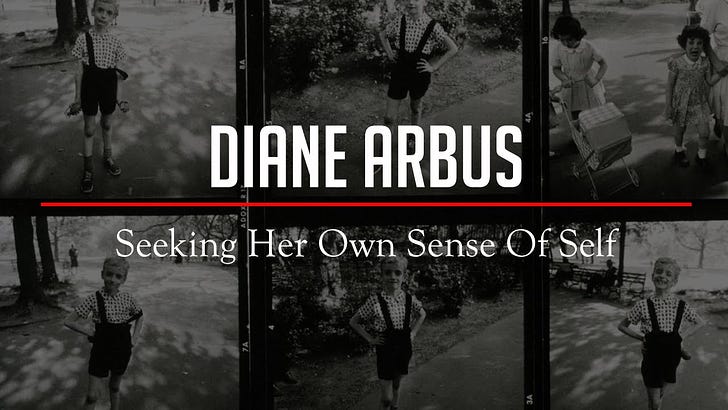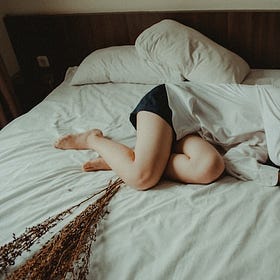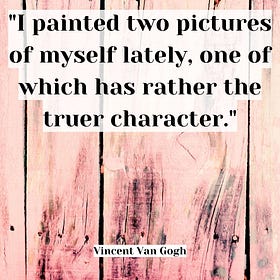Art History Meets Psychology: A Collection of Essays
Looking at the nuanced relationship between creativity and mental health among a selection of artists from across time.

I write about the intersection of art and mental health from the perspective of my own lived experience. And also from interviews with others. And sometimes from something I’m reading in contemporary books. But I also have a love for looking back at art history through the lens of mental health and considering the nuanced ways that psychological challenges may have impacted or been impacted by an artist’s creativity.
My book, The Artist’s Mind, is all about this, and I feel like that book was really just a starting point for my research. This post is where you’ll find a regularly-updated list of the essays I write on this topic.
Looking at Specific Artists
Art and Mental Health History: Sonja Sekula
Open about being a lesbian, regularly hospitalized for mental health challenges, working on a small scale when other Abstract Expressionists worked large ... Sekula's differences limited her fame.
Her creative productivity tended to go through cycles, and it’s hard to tell if that was a result of the moods and inspiration of her mental health, the status of her hospitalization, or (likely) some combination of both.
Leonora Carrington Art and Mental Health
“Art is a magic which makes the hours melt away and even days dissolve into seconds.” - Leonora Carrington
This is an edited selection of The Artist's Mind chapter on Leonora Carrington. Following that are two pieces of the original manuscript that didn’t make it into final publication: a closer look at one specific piece of art (Samhain Skin) and four “fun facts”.
Isa Genzken: A Half Century of Prolific, Innovative Art and Openness on Bipolar Symptoms
“I always wanted to have the courage to do totally crazy, impossible, and also wrong things.” -Isa Genzken
Isa Genzken’s intense artistry, marked by periods of institutionalization and alcoholism, has defined contemporary art for over 50 years. This essay examines the complex relationship between her work and mental health, while acknowledging that Genzken herself may not view it this way.
Art History and Mental Health: Surrealist Kay Sage
Do the desolation, prison-like scaffolding, and muted colors of Sage's dreamscapes reflect a history of depression?
In the end... her eyesight was failing, and the combination of those things led to depression, decline in her work, and ultimately suicide. And yet, through those last years, she continued to create, to put together collections of Tanguy’s work, to write poetry and create assemblage pieces, to mount a final show.
Art and Mental Health History: Carlo Zinelli
Exploring the complex, problematic term and history of "outsider art" and looking at the relationship between art and mental health in the life of Carlo Zinelli, a so-named "outsider artist."
Michelangelo Buonarroti: Art and Mental Health History
Michelangelo may be best recognized for painting the ceiling of the Sistine Chapel. However, the world is lucky he managed to complete the magnificent mural at all. Letters indicate that he dragged through the work in a state of exhaustion and depression. It probably didn’t help matters that the artist didn’t enjoy painting; he considered himself a sculptor and took painting commissions in order to pay the bills. Many working artists will recognize this struggle to find a balance between working creatively and working for financial stability, and artists who struggle with mental health issues may find this balance to be particularly precarious.
Arthur Bispo do Rosario: An Unfinished Chapter of The Artist’s Mind by Kathryn Vercillo
Brazilian artist Arthur Bispo do Rosario spent time in the navy and competed as a boxer, but when he was in his late twenties (his exact date of birth is unknown), he had a psychotic episode characterized by hallucinations. After having a vision in which God and seven blue angels descended from the sky, he came to believe that his life’s mission was to recreate the entire universe so that he could present the improved version to God when that day arrived. Believing that he was “conducting an army of angels,” Bispo entered a monastery and announced that he was there to make judgment upon both the living and the dead. He was diagnosed with paranoid schizophrenia and hospitalized, spending the next five decades in Rio de Janeiro asylums.
Once institutionalized, Bispo became a prolific artist.
Pain, Parties, Work … Sylvia Plath’s Bell Jar Summer
Elizabeth Winder’s look at Sylvia Plath’s summer of 1953 unveils the deep interplay between her mental health and creative expression. Plath’s unexpected passion for fashion became an outlet for identity and joy, but her battles with depression surfaced in moments like tossing her clothes out the window. Subtle shifts in her handwriting, relentless exhaustion, and a craving for rest illuminated how her mental state affected her ability to create. Choosing the seagull as her spirit animal hinted at her quiet resilience, while her early fascination with psychology later influenced her most profound works. These glimpses capture the intricate relationship between creativity, mental health, and the pressure of external expectations during that key summer of the author's life.
DIANE ARBUS: Where Art Meets Mental Health
Five essays exploring Arbus' complicated family dynamics, history of depression, multilayered sexuality, and other things that may have helped shape the direction of the photographer's creativity
Georgia O'Keeffe: Where Art History Meets Mental Health
Five essays each exploring different part of O’Keeffe’s creative journey and how they were shaped by both her mental health and her relationships.
History’s Mental Health Diagnoses Among Artists
The Impact of Hysteria Diagnosis on Women in Art History
How Camille Claudel, Dora Maar, Emily Dickinson and others were affected by an outdated psychological diagnosis that pathologizes women's creativity. For women artists, the impact of a hysteria diagnosis was particularly devastating. The very qualities that are often essential to artistic expression—emotional depth, creativity, sensitivity, and a keen awareness of one's surroundings—were pathologized as symptoms of hysteria. Women who exhibited these traits were labeled as unstable and mentally ill, rather than being recognized for their artistic talents. This stigmatization not only devalued their creative work but also marginalized them within the art community.
Art History and Outdated Mental Health Diagnosis: Neurasthenia
The Rest Cure, Women on the Verge, Alice Neel's escape from the diagnosis, and more about artists said to have had neurasthenia ... Neurasthenia was a condition not entirely dissimilar to depression in that symptoms included trouble sleeping and eating, physical aches and pains, and listlessness. However, it was specifically diagnosed in relation to the belief that “the harsh conditions of modern industrial society had generated new nervous disorders.” While both men and women might receive a diagnosis of neurasthenia, the suggested cure was deeply gendered; men were encouraged to get out of the city by adventuring West or into the forests whereas women were told to go on complete bed rest and couldn’t even read, write, or have visitors for weeks or even months on end.
From Neurasthenia to Shadowbanning
The shadowbanning of these contemporary artists parallels historical practices of erasure and infantilization, as seen in 19th-century paintings of white, upper-class women. During this era, male doctors routinely disregarded women's autonomy and prescribed the "rest cure" to manage various ailments, reinforcing patriarchal power dynamics. Similarly, modern algorithms perpetuate these historical biases by rendering certain bodies invisible, thus perpetuating limiting narratives and hindering progress toward inclusivity and equity online.
Melancholia: Albercht Durer
A history of the mental heath diagnosis melancholia, how it relates to what we call depression today, the distinction between melancholia and melancholic art, and a look at Albrecht Durer's Melancholia art piece.
Multi-Artist Essays About Specific Mental Health in History Topics
Asylum Art: Artists Who Created While Living in Psychiatric Institutions (And Those Who Did Not)
Aloise Corbaz, Barbara Suckfull, Bryan Charnley, Camille Claudel, Louis Wain, Martin Ramirez, Unica Zurn and more than a dozen other artists who did and didn't create while in inpatient care. What made it so that some saw their creativity flourish in institutions and for others it was stifled?
Where does the "truth" lie in a self portrait? What history's artists reveal ..
Self-portraits can act as windows into how artists perceive themselves during periods of emotional struggle or stability. For instance, works like Gauguin’s Self-Portrait (Near Golgotha) and Kirchner’s Self Portrait as a Sick Man show that depression and fatigue can deeply influence artistic choices, from posture to color palette. Frida Kahlo’s self-portraits emphasize her search for identity and her complex relationship with self-worth, shaped by her traumatic experiences. We explore this and then consider nine questions to ask yourself as you try your own self portrait.
9 Mental Health Lessons from Famous Artists
Explore powerful mental health lessons from famous artists who faced personal and societal challenges. Gustave Doré’s work, for instance, reflects the depression he experienced within the context of 19th-century misère—showing how societal struggles intersect with personal mental health. Meanwhile, artists like Joan Miró and Alice Neel exemplify how creative resilience can thrive even amid persistent emotional struggles.
And One Guest Post
Richard Dadd: Excerpt From The Artist’s Mind. After murdering his father during psychosis, Richard Dadd lived and created his art in a psychiatric prison.




